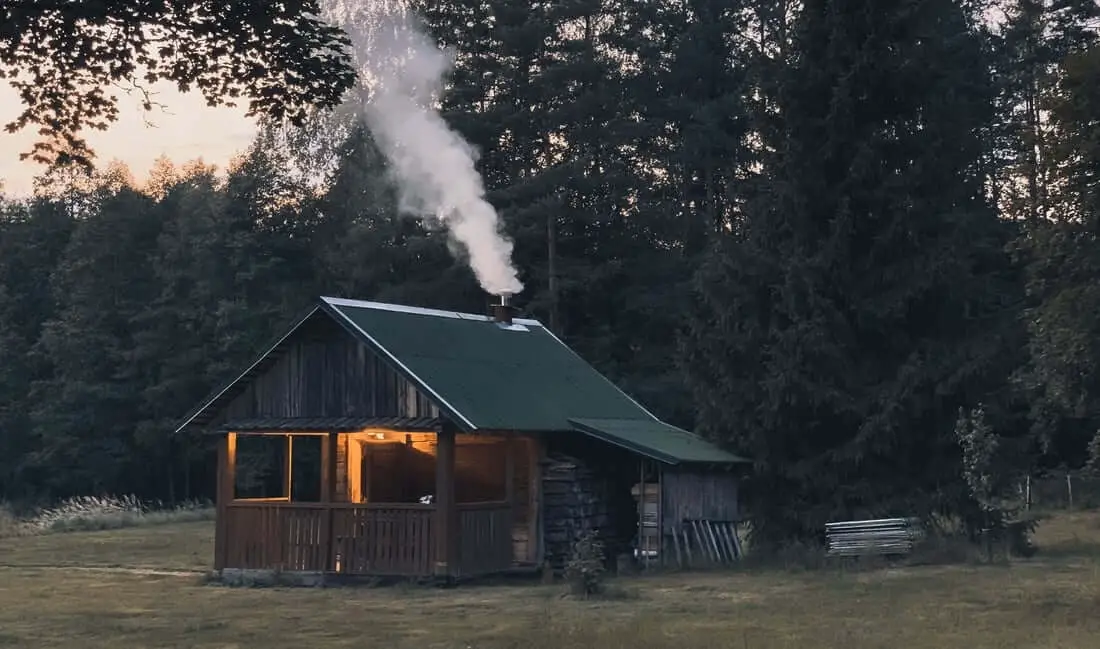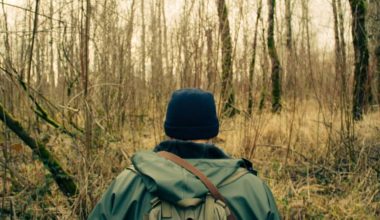Picking a good bug out location is one of the most important things you can do if you’re serious about prepping.
If you live in a big city (or near one) it’s in your best interest to distance yourself as much as possible in a SHTF scenario. A large group of people panicking and becoming desperate for resources is not something you want to worry about.
The thing is, a lot of people know that they need a bug out location of some sort but there’s not sure where to start. They know they should find a place to get away from the turmoil, but they aren’t sure of the details.
And the details are what matter most.
You see, the best bug out locations all have a few things in common. These characteristics are what make a safe haven when things go bad (instead of just a plot of land).
In this guide, you’ll learn everything you need to know about bug out locations and what to look for when establishing your own. By the time you’re done reading this, you’ll have the actionable info you need to take the next step and keep you and your family safe.
Table of Contents
1. Accessibility
One of the first things you need to think about when picking a bug out location is how easy it is to access. You don’t want it to be TOO accessible, but you also don’t want it to be a three-day drive away as well.
You want to be able to get to your bug out location relatively quickly from the city that you live in. In a SHFT scenario, everything will start to happen very fast and you won’t have a bunch of time to get ready to leave (it’s not like taking the family for a casual road trip).
Every unnecessary mile you have to travel is another mile that you could encounter an obstacle or problem. While you might think that will make it safer once you get there (more on that in the following section), none of that matters if you can’t get there safely in the first place.
Take some time to think about the safest route to take when traveling to your bug out location. Assume that the main roads and highways will either be closed or bogged down with traffic. This means you need to identify a primary route where you can travel safely and undisturbed.
Quick Tip: Also make sure that you have backup routes that can be taken if your main choice isn’t an option for whatever reason. Backup plans and redundancy are themes that you’ll see often among smart preppers.
Make sure that you have enough gas on you to make it to your bug out location without a problem. You can’t expect gas stations to be open or accessible, so you need enough fuel to make it to your destination. Keep gas canisters at your home if the distance exceeds a tank (or if your car has poor gas mileage).
If getting to your bug out location requires you to do any walking you’ll need to be prepared for that as well. Stretching out the hike for longer than 5 days is not smart because it will require you to carry significantly more gear just to make it to your destination.
If you’ve found a spot that you think has promise, run through a mental scenario before making a purchase. Imagine everything has gone wrong and you’re at your house.
If you’re having trouble believing you’ll be able to make it to your bug out location 100/100 times, start looking for another spot. It doesn’t matter how perfect the location is if you can’t make it there safely.
2. Buffer Space
Buffer space is one of the most important factors when it comes to the safety of your bug out location. All of the best locations put a significant distance between them and the chaos that’s happening in the rest of the world.
You could have the best bug out location in the world in terms of what’s on the land itself, but if it’s close to a city it’s not going to be safe for long.
Part of the reason you want this buffer space is simply because the majority of the general population will not be able to make it to your bug out location. Putting distance between you and them will significantly reduce the amount of potential unfriendly encounters you face.
This makes it was easier for you to defend your space and monitor your land for trespassers or people who mean you harm.
One thing that a lot of experienced preppers recommend is trying to make sure your whatever shelter or structure you have on the land is not easily visible. This means having it tucked away from the road and ideally not visible from the air too (trees are your friends). This is just another way to fly under the radar.
3. Nearby Water
This is one of the factors that can complicate your search for the perfect bug out location. It’s not that hard to find some land away from the crowd, but land with a source of water is a whole other story.
But trust us, it’s worth the extra time you spend searching.
As you probably know by now, water is about as important as it gets when it comes to survival. You won’t last long without it!
Having a source of water at your bug out location is not only convenient, but it’s also safer too. When you don’t have to leave your land for water this reduces the number of potential encounters significantly.
Leaving to go duke it out with desperate people for water is not something you want to do. Let the unprepared do that while you stay put.
Any lake, pond, river, or stream is an option. It doesn’t have to be massive either. The most important thing is that it’s consistently available and something you can rely on year-round.
You’ll be making many trips there to collect water for cooking, bathing, or to filter.
- 100,000 gallon filter lifespan
- Filters down to 0.1 microns
- Removes 99.9999% of bacteria and protozoa
- Lightweight and portable
If you’ve searched high and low for a bug out property with a source of water and have come up empty, there is something else you can do. There are large water storage containers you can use to safely keep water for long periods of time, or you can use a water collection system.
Bonus Survival Tip: If you have a river or stream on your property that’s moving fast enough then it can be used to generate energy as well. Water can be used for more than just drinking!
4. Living Structure
Having a plan behind the kind of long-term survival shelter you want to place at your bug out location is important too.
You might be able to find a perfect bug out property that has an existing structure on it that you can work with. Other times you’ll need to build your own.
Regardless, you’ll need to do some work to make sure the actual structure you’re going to be using is suitable for a SHTF scenario. Think about the weather the area faces and if you’ll be protected from the elements.
This is a topic that has differing opinions from the prepping and survivalist community. Some people believe that a simple, no-frills structure is best because it’s unassuming and hard to spot. Others think that you should go the extra mile and maximize security, comfort, and safety.
In our opinion, there’s a happy medium between these two viewpoints. We’re not fans of people living in a primitive structure at their bug-out location because it’s harder to defend and keeps you more exposed to the elements. However, building a big compound is not a good idea either.
A small cabin is a good choice because it’s sturdy, insulated, affordable, and unassuming.
5. Long Term Sustainability
The best bug out locations are set up in a way that the owners can survive there for an extended period of time. You don’t want to arrive at the property and have only a week before you have to venture into the chaos to try and find supplies or food.
Food, water (already mentioned above), and energy all play a part in this. Try and envision this before you purchase a property.
Is it possible for a garden to thrive? Is there adequate sunlight, sufficient room, and the right soil to allow plants to grow? This is the most predictable source of food you have, so you want to make sure it’s an option (bonus points if you can fish on your property).
The presence of other animals to hunt or trap is also a good sign. This will allow you to be more sustainable and keep your energy up.
Sunlight can also be used for various solar-powered systems. Many survivalists advocate doing what you can do conceal these as much as possible, so try and tuck them out of the way while still giving them plenty of sun exposure.
Trees are another thing that can make a big difference. Wood can be used to make structural repairs or heat your home in the cold months. Having an abundance of wood on your property can make a big difference in the long run.
6. Defendability
This is something that can get overlooked. While the property bug out location placement will drastically reduce your chance of having an unwanted encounter, it’s still always a possibility.
This means you should take a little time to think about how easy it will be to defend your home if need be. While we don’t recommend building an all-out fort, a little bit of that mindset will be useful.
Having good lines of sight and places to lay defense traps can provide peace of mind. Your structure itself should also give you the ability to cover all angles of the home with minimal blind spots.
Concealment is also something that we want to include in this section as well.
Your ability to disguise your setup a bit and not advertise your presence is incredibly valuable. This goes for your living structures, vehicles, and driveways or trails. All of these things can attract unwanted attention from desperate people in a SHTF scenario.
Covering up reflective surfaces during the day and making your fires at night are two examples of simple actions that won’t draw attention to you and your family.
Additional Considerations
Those are the main factors you want to consider when picking the best bug out location for you. However, there are some other things you’ll need to consider when getting started.
It’s important to be aware of these ahead of time so you don’t find yourself in a situation where you have to compromise. A good bug out location covers all the bases, and you don’t want there to be any holes in your gameplan when SHTF.
Cost
The unfortunate reality is that the best bug out locations are typically more expensive than a lot of the other pieces of land you look at. This can make the process frustrating and often baits people into buying a subpar property because they just want to get going right away.
This is where you have to be smart and think long term. While you might be excited and want to start setting up your bug out location ASAP if it’s not suitable from the get-go there’s no point.
The other thing you need to fight is the urge to snag a spot because you feel like you’re not prepared if you don’t own something. While it might seem slightly counterintuitive compared to our general philosophy (being prepared is a necessity), you might need to have a little patience.
Buying an affordable but insufficient bug out location might seem like progress, but if it doesn’t get the job done you’re only slightly more prepared for a SHTF situation than you were before.
Then you need to factor in the cost of work and setup. While there might be a cheap piece of land that you can afford in the short term, you’ll likely spend more (in money and time) later to make it serviceable.
For example, if you want to keep a garden but the land doesn’t support one naturally then it’s going to cost you more later to landscape and build one. Or if your bug out location doesn’t have a source of water nearby, it’s going to be an ongoing expense to make sure you have a stockpile of drinkable water there at all times.
Basically, think about all of the expenses from A-Z. Don’t get caught up in looking at the upfront cost of a property and thinking that’s all there is to it. Sometimes a more expensive property will actually be cheaper and safer for you in the long run.
Building Regulations
This is one of the most annoying parts of the process, but it has to be done. In a SHTF scenario, the government likely won’t care or enforce what you’re up to on your property. However, they will until that happens.
Even if you plan on building something primitive and staying under the radar it’s smart to check the local building and zoning regulations (do this before you buy a property obviously).
This sort of thing can add major headaches to the building process and drain additional time and resources that you could use on more efficient things (like supplies). For the most part, a standard bug out location and structure shouldn’t cause too many issues with your local government, but it’s always a good idea to check anyway.
Natural Disaster Probability
The best bug out locations are found in places where there are low chances of natural disasters. This is not only good for your long-term sustainability but the viability of your location in the short term.
Here’s why:
Some of the potential SHTF situations you might face could be caused by natural disasters (or trigger them later). If your bug out location is in the danger zone that means you might not be safe when you get there.
Or, it might not be in one piece when you arrive.
Having a strong understanding of your area and where you’re planning on having your bug out location is crucial if you want to avoid this. Take some time to learn the area from a macro and micro perspective so you can understand probabilities and risk going into the buying process.
You might live in an area where there’s always going to be a chance of a natural disaster unless you drive a few days (Tornado Alley for example). In this situation, it’s smart to build your bug out location with that in mind.
If tornadoes are a possibility, a sturdy structure with a basement and places to store food and supplies is a must. If floods are a danger, build high.
The two that are hard to fight are earthquakes and hurricanes. That’s why the best bug out locations are never on the coast.
Length Of Stay
The length of stay you want to prepare for will impact the kind of bug out location you need and how to set it up.
While we always advocate a bug out location that you can stay at for a long period of time, your risk tolerance and budget might impact this. Do an assessment of what you want and how prepared you want to be when it comes to the length of your stay. This will impact a lot of the other things on our list.
One option you have is setting up your bug out location for a shorter stay and then developing it over time to make it more sustainable. This can be a more budget-friendly option that will keep you making progress.
Conclusion
When it comes to setting up the best bug out location for you, this checklist should serve you well. It’s not complicated and will keep you from making any mistakes or overlooking essential features that good locations have.
Use it as your guide when looking for a property, or setting it up. If you keep the main principles in mind throughout this process you’ll be far more prepared if things take a turn for the worse.
Take your time, make a smart purchase, put in the work, and you’ll be ready no matter what happens.



